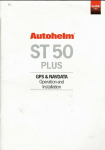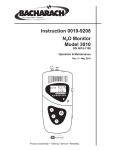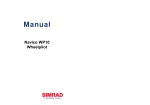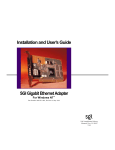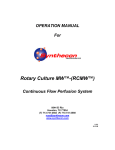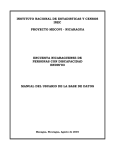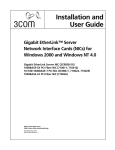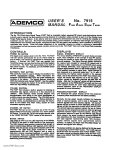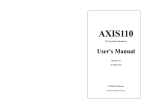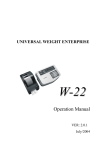Download Raymarine ST30 Product specifications
Transcript
Distributed by Any reference to Raytheon or RTN in this manual should be interpreted as Raymarine. The names Raytheon and RTN are owned by the Raytheon Company. TOP EDGE BLEED MASK FOR 2 COLOUR SEATALK LOGO ST 30 SPEED Operation and Installation TOP EDGE BLEED MASK FOR 2 COLOUR SEATALK LOGO Nautech Limited, Anchorage Park, Portsmouth P03 5TD, England Telephone (0705) 693611. Fax (0705) 694642 ST30 Speed Operation and Installation Handbook ots Kn IP TR MA L TA TO UM XIM GE RA E AV PL DIS AY D EE SP TM D582 Autohelm and SeaTalk are registered Trade Marks of Nautech Limited Autohelms policy of continuous improvement and updating may change product specifications without prior notice Copyright Nautech 1992 ST30 Speed Operation and Installation Handbook Package Contents The following items are included in the ST30 Speed package: 1. ST30 Speed instrument 2. Fixing studs (2 off) 3. Thumb nuts (2 off) 4. Fitting template 5. 1m power cable 6. Paddle transducer (through hull) with 10m cable and 1/8in spade connectors (0 to 32 knots) 7. Instrument cover 8. Operation and installation handbook 9. High speed paddlewheel (2 to 45 knots) 10. Daisy-chain cable 1 2 3 6 TRIP TOTAL MAXIMUM AVERAGE DISPLAY SPEED B B B ST30 INSTRUMENT MOUNTING TEMPLATE 7 4 2-HOLES DRILL 5mm ( .197in ) DIA SeaTalk 1-HOLE DRILL 60.3mm ( 2,3/8in ) DIA SeaTalk SeaTalk SeaTalk 5 ST30 10 SPEED Operation and Installation 9 8 D581 ST30 Speed Operation and Installation Handbook 3 Contents Introduction ....................................................................... 4 Chapter 1: Control Head Installation ................................... 5 1.1 Siting ............................................................................. 5 1.2 Mounting procedure ........................................................ 6 1.3 Power supply (Stand-alone operation) ............................... 7 1.4 Power supply (SeaTalk operation) ..................................... 7 1.5 Connection to adjacent ST30 instruments ......................... 8 Chapter 2: Transducer Installation ...................................... 9 2.1 Connection to instrument ................................................. 9 2.2 Transducer type ........................................................... 10 2.3 Paddlewheel replacement .............................................. 10 2.4 Installation .................................................................... 12 Speed transducer (through hull) ...................................... 12 2.5 Cabling ........................................................................ 13 Chapter 3: Fault Finding ................................................... 14 Chapter 4: Maintenance ................................................... 15 4.1 Instrument .................................................................... 15 4.2 Transducer ................................................................... 15 4.3 Cabling ........................................................................ 15 4.4 Advice .......................................................................... 15 Chapter 5: Operation ....................................................... 16 5.1 Display Key .................................................................. 16 Trip Distance display ..................................................... 17 Total Distance display .................................................... 17 Maximum Speed display ................................................ 18 Average Speed display .................................................. 18 5.2 Light Key ...................................................................... 19 Chapter 6: Calibration ..................................................... 20 6.1 Normal Calibration ........................................................ 20 Speed units selection (knots/mph) .................................. 20 Logs units selection (nm/miles) ...................................... 21 Exit calibration .............................................................. 22 Log calibration .............................................................. 22 Enter calibration factor (CF) ............................................ 23 Exit calibration .............................................................. 24 6.2 Calibration Lock/Unlock ................................................ 24 Return to normal display ................................................ 25 6.3 Master/Repeater display ............................................... 26 Return to normal display ................................................ 27 Chapter 7: General Specification ...................................... 28 ST30 Speed Operation and Installation Handbook 4 Introduction Designed for above or below deck installation, the ST30 Speed can be used as a stand-alone master instrument or can be set to repeat speed information from the SeaTalk bus. The ST30 Speed will display the following information: • Boat speed • Log • Trip • Maximum speed • Average speed • Illumination level ots Kn IP TR L TA TO MA XI M MU GE RA E AV Y LA SP DI D EE SP TM D582 5 Chapter 1: Control Head Installation Chapter 1: Control Head Installation 42mm (1.65in) 110mm (4.33in) 56mm (2.20in) TRIP TOTAL MAXIMUM AVERAGE DISPLAY Autohelm 88mm (3.46in) 24mm (1.0in) SPEED D583 1.1 Siting The ST30 Speed may be installed above or below deck where it is: • easily readable by the helmsman (normally viewed at eye level) • protected from physical damage • at least 230mm (9in) from a compass • at least 500mm (20in) from radio receiving equipment • accessible from behind for ease of installation and cable running Note: To prevent the build-up of moisture the instrument breathes through the back cover. For this reason the instrument must be mounted where the back cover is protected from direct water. The rear case is fitted with a foam gasket to form a water-tight seal between the instrument and the installation face. ST30 Speed Operation and Installation Handbook 6 1.2 Mounting procedure 3 5 6 2 4 1 D584 1 Instrument 2 Fixing studs 3 Thumb nuts 4 Sealing gasket 5 Power supply cable 6 Transducer cable 1. Make sure the surface to which the instrument (1) is to be mounted is smooth and flat. 2. Use the template (supplied) to mark the centres for the two fixing holes and the instrument connector boss. Note: To allow protective covers to be fitted, adjacent instruments should be sited not less than 6mm (0.24in) from each other (116mm centre to centre min.). 3. Drill two 5mm (0.2in) diameter holes for the fixing studs (2). 4. Using a 60mm (2 3/8in) diameter cutter, drill a location hole for the instrument connector boss. 5. Connect the power supply and transducer cables to the back of the instrument (1) (see relevant installation sections). 6. Screw the two fixing studs (2) into the back of the instrument (1). 7. Install the instrument (1) in the chosen location and secure with the thumb nuts (3) provided. 7 Chapter 1: Control Head Installation 1.3 Power supply (Stand-alone operation) Caution: The ST30 Speed must only be connected to a 12V supply. + + D EE SEATALK SP + + 5A + 12V Supply Red – Screen D585 For stand-alone operation, use the 1 metre cable supplied with the instrument. 1. Connect the moulded power supply plug to either SeaTalk connection on the rear of the instrument and run the free end back to the vesselÕs distribution panel. 2. Cut the power cable to length and connect the red wire to the positive 12V terminal and the screen to 0V. Protect with a 5A circuit breaker or fuse. 1.4 Power supply (SeaTalk operation) If the ST30 Speed is to be connected to an existing SeaTalk system use a Standard SeaTalk Extension or Interface cable. Autohelm Autohelm Autohelm Power Extension Cable D628 8 ST30 Speed Operation and Installation Handbook 1.5 Connection to adjacent ST30 instruments The ST30 Speed is supplied with a daisy-chain cable that allows adjacent ST30 instruments to be linked together. The daisy-chain cable supplies power to adjacent instruments and allows data to be transmitted and received via the SeaTalk bus. The daisy-chain cable plugs into one of the SeaTalk ports on the back cover. 9 Chapter 2: Transducer Installation Chapter 2: Transducer Installation 2.1 Connection to instrument The transducer is supplied with 10m (32.5ft) of cable that plugs directly into the back of the instrument. + + D EE SEATALK SP + + D586 ST30 Speed Operation and Installation Handbook 10 2.2 Transducer type The ST30 Speed system is supplied, as standard, with a plastic through hull transducer. This is suitable for use with Glass Reinforced Plastic (GRP), Steel and Aluminium hulls at speeds up to 32 knots. Wooden hull and transom mount installations require a different type of transducer. Please refer to the following table for details. Hull material or Boat speed (max) Transducer type location GRP, Steel, Aluminium 32kts Standard through hull GRP, Steel, Aluminium 45kts Standard with high speed paddle Wood 45kts Bronze (Z116) Transom 60kts Transom mount with bracket (Z119) Caution: Plastic through hull transducers must not be used on vessel's with wooden hulls. Note: The ST30 speed transducers are fitted with standard paddlewheels designed for speed up to 32 knots. For vessel's that will exceed this speed, please refer to section 2.3 which contains instructions on how to fit the high speed paddlewheel (supplied). 2.3 Paddlewheel replacement If the high speed paddlewheel (supplied) is to be fitted, or the existing paddlewheel to be replaced, proceed as follows: 1. Remove the retaining rings (1) and pin (6) from the speed transducer (3). 2. Withdraw the speed transducer (3) from the through hull fitting (4). 3. If replacing a worn paddlewheel and if the vessel is still in the water, replace the speed transducer (3) with the plug (5). 4. Remove the pin (6) that retains the paddlewheel (7) in the speed transducer (3). This is a simple press fit into the transducer housing. 11 Chapter 2: Transducer Installation 5. Fit the high speed/replacement paddlewheel (7) to the speed transducer (3) and retain with the pin (6). Note: The paddlewheel is correctly orientated when the working surfaces of each paddle are facing forwards. 6. Assemble the speed transducer (3) to the through hull fitting (4) and secure with retaining rings (1) and pin (2). 3 6 5 7 8 2 1 4 D587a ST30 Speed Operation and Installation Handbook 12 2.4 Installation All speed transducers are supplied with detailed installation and maintenance instructions. These instructions, together with the following notes, should be read thoroughly before attempting to install the transducer. Speed transducer (through hull) For accurate speed readings, locate the speed transducer in the shaded 'clear flow' areas as shown. D587 The transducer should also be: • ahead of propellers (10% W.L. length minimum) • at least 150mm (6in) from the keel (with sailing yachts siting should be forward of the keel). • near the centreline of the vessel • clear of other through hull fittings or projections • have sufficient clearance inside the hull to allow the nut to be fitted • have 100mm (4in) clearance above the through hull fitting for withdrawal 13 Chapter 2: Transducer Installation 2.5 Cabling Run the transducer cable back to the instrument. Avoid fluorescent lights, engines and radio transmitting equipment. The transducer cable should also be kept clear of bilge's, where possible, and be secured at regular intervals. Note: The transducer cable can, if required, be shortened. However, new 1/8in spade connectors must be crimped to the shortened cable. If the bronze through hull (Z116) or the transom mount (Z119) transducers are to be used, the following modification must be carried out on the transducer lead. 1. Using a pair of wire cutters, remove the moulded plug from the end of cable. 2. Strip the outer cable back 38mm (1.5in). 3. Using a pair of cable strippers, remove 10mm (3/8in) of insulation from each wire. 4. Using a suitable crimping tool, attach a 1/8in spade connector (supplied) to each of the wires. 5. Connect the wires to the instrument in accordance with the following table. Transducer type Colour coding (cable to unit) Bronze through hull (Z116) Brown and white Ð cut back Green Ð green terminal Screen Ð white terminal Red Ð red terminal Transom mount (Z119) As above ST30 Speed Operation and Installation Handbook 14 Chapter 3: Fault Finding All Autohelm products are, prior to packing and shipping, subject to comprehensive test and quality assurance programmes. However, if a fault arises with the ST30 Speed, the following table will help to identify the probable cause and provide the most likely cure. Fault Cause Action Instrument display blank No supply to instrument Check supply Check cabling and security of connectors Check circuit breaker Return ST30 Speed for repair No speed information Transducer cabling problem or fouled Clean paddlewheel No exchange of information between SeaTalk instruments SeaTalk cabling or connector problem Check security of SeaTalk connectors Remove instruments one by one to isolate faulty unit Failure of a group of Cabling or connector instruments in a chain problem Check the security of the connectors between functioning and non-functioning instruments Unable to enter calibration Refer to Calibration lock/unlock section Calibration locked 15 Chapter 4: Maintenance Chapter 4: Maintenance 4.1 Instrument Certain conditions may cause condensation to appear on the instrument window. This will not harm the instrument and can be cleared by increasing the illumination setting to level 3. Chemical and abrasive materials must not be used to clean the ST30 Speed instrument; if the instrument is dirty, clean with a soft, damp cloth. 4.2 Transducer Refer to the Installation and Maintenance instructions supplied with the transducer. 4.3 Cabling Examine all cables for chafing or damage to the outer shield and, where necessary, replace and re-secure. 4.4 Advice For advice, or further information regarding installation of this product, please contact the Autohelm Product Support Department or your own National Distributor. ST30 Speed Operation and Installation Handbook 16 Chapter 5: Operation The ST30 Speed leaves the factory set to: • display speed in knots • display distance in nm • Master mode These settings can be changed in calibration. When the ST30 Speed is powered on the instrument displays 'Boat Speed'. TRIP TOTAL MAXIMUM Knots AVERAGE SPEED D605 DISPLAY 5.1 Display Key Each press of Display cycles the following menu: • Trip distance • Total distance • Maximum speed • Average speed A further press will return the display to the current boat speed. The maximum speed and average speed displays will automatically return to current 'Boat Speed' after 8 seconds. 17 Chapter 5: Operation Trip Distance display 1. Press Display to select 'Trip Distance'. TRIP TOTAL Nm MAXIMUM AVERAGE Cal. SPEED TM 2. D600 DISPLAY To reset Trip Distance to zero, press and hold for 3 seconds. The trip display will flash on and off before resetting to zero. TRIP TOTAL Nm MAXIMUM AVERAGE SPEED TM D601 DISPLAY Total Distance display Press Display to select 'Total Distance'. The Total Distance display shows the total distance covered in nm or miles. TRIP TOTAL MAXIMUM Nm D602 AVERAGE TRIP AVERAGE Nm D602A TOTAL MAXIMUM Note: If this distance exceeds 1000nm/miles, it will be displayed in thousands, hundreds and tens (e.g., 1th, 510). ST30 Speed Operation and Installation Handbook 18 Maximum Speed display 1. Press Display to select 'Maximum Speed'. This display shows the maximum speed achieved in knots or mph. TRIP TOTAL MAXIMUM Knots AVERAGE SPEED TM 2. D603 DISPLAY The maximum speed display is reset by pressing for one second. TRIP TOTAL MAXIMUM Knots AVERAGE SPEED TM D604 DISPLAY Average Speed display Press Display to select 'Average Speed'. This display shows the average speed in knots or mph. TRIP TOTAL MAXIMUM Knots AVERAGE DISPLAY TM SPEED D605 1. 19 Chapter 5: Operation 2. The Average Speed display may be reset by pressing second. for one TRIP TOTAL MAXIMUM Knots AVERAGE SPEED TM D606 DISPLAY 5.2 Light Key The key controls the level of instrument illumination. There are 3 levels, with level 3 the brightest. TRIP TOTAL MAXIMUM AVERAGE TM SPEED D607 DISPLAY Note: When the ST30 Speed is used in a SeaTalk system, the level may be adjusted from any instrument. 20 ST30 Speed Operation and Installation Handbook Chapter 6: Calibration 6.1 Normal Calibration The ST30 Speed can be programmed to display speed information in knots or mph and distance in nm or miles. To select the calibration menu, press and hold Display and seconds the display will show CAL. TRIP TOTAL MAXIMUM AVERAGE Cal. SPEED TM D590 DISPLAY Each press of Display will cycle through the calibration menu. Speed units selection (knots/mph) Press Display for selection of knots or mph. TRIP TOTAL MAXIMUM AVERAGE Cal. Knots DISPLAY TM SPEED D591 1. . After 2 21 Chapter 6: Calibration 2. Press to change the selection. TRIP Mph TOTAL MAXIMUM AVERAGE Cal. SPEED TM D592 DISPLAY Log units selection (nm/miles) 1. When Units Selection (nm/miles) is cycled the display shows nm or miles. TRIP NM TOTAL MAXIMUM AVERAGE Cal. SPEED TM Press to change between nm and miles. TRIP TOTAL Miles MAXIMUM AVERAGE Cal. DISPLAY TM SPEED D594 2. D593 DISPLAY ST30 Speed Operation and Installation Handbook 22 Exit calibration Press Display and TRIP for 2 seconds. Mph TOTAL MAXIMUM AVERAGE TM SPEED D597 DISPLAY Log calibration The ST30 Speed should not be used for navigational purposes until the transducer paddlewheel has been calibrated to suit the characteristics of the vessel. This is a simple operation and is carried out as follows: 1. Choose two charted points that are approximately 1nm apart. Point 1 Point 2 Approximately 1Nm D699 2. Choosing a time when the tidal flow is at a minimum, go from point 1 to point 2 and record the ST30 Speed trip distance. 3. Go from point 2 to point 1 and record the trip distance. 4. Add the two distances together and divide by two to obtain an average distance. 23 Chapter 6: Calibration 5. Measure the distance between the two points on a chart. 6. The correction factor (CF) can now be calculated. CF = Charted Distance Average Distance Enter calibration factor (CF) 1. Press Display and for 2 seconds until CAL is displayed. TRIP TOTAL MAXIMUM AVERAGE Cal. SPEED TM 2. D590 DISPLAY Press Display until Log Cal is shown in the window. TRIP TOTAL MAXIMUM AVERAGE Cal. SPEED TM Press or to enter the calculated correction factor. TRIP TOTAL MAXIMUM AVERAGE Cal. DISPLAY TM SPEED D596 3. D595 DISPLAY I 24 ST30 speed opera&m and bEtanation Handbodl Exit calibration To exit calibration and r&m to speed, press and hdd 2 seconds. Disdw and 38 for 6.2 Calibration Lock/Unlock The lock/unlock feature removes the risk of accidentally changing tie calibration values set for log calibration, shallow alarm etc. For securii, the calibration lock/unlock feature is accessed by an extended hold down of the * and Display keys as follows: 1. Press and hold Diiplay and *for 14 seconds until CAL is displayed forthe second time. Chapter 6: Calibralion 25 2. Momentarily press A and V together. CO = Calibrtion locked, i.e. IX) access Cl = Calibration unlocked, i.e. normal access 3. Mode selection is altered using A key. Return to normal display Press and hold Display and *. After 2 seconds the display returns to ‘Speed’ mode. ST30 Speed Operation and Installation Handbook 26 6.3 Master/Repeater display As it leaves the factory, the ST30 Speed is set to operate in Master mode. In this mode the instrument is connected to a speed transducer and transmits speed information onto the 'SeaTalk' bus. The ST30 Speed can be set up as a Repeater, repeating speed information already on the 'SeaTalk' bus. Repeater mode is set as follows: 1. Press and hold Display and figure number. until the display shows U and a two TRIP TOTAL MAXIMUM AVERAGE SPEED TM Press Display to display the operating mode. r0 = Master mode r1 = Repeater mode TRIP TOTAL MAXIMUM AVERAGE DISPLAY TM SPEED D609 2. D608 DISPLAY 27 Chapter 6: Calibration 3. Press to change mode. TRIP TOTAL MAXIMUM AVERAGE SPEED TM D610 DISPLAY Note: Normal calibration is not available when the ST30 Speed is set to Repeater mode. Return to normal display To exit calibration and return to speed, press and hold Display and 2 seconds. TRIP Mph TOTAL MAXIMUM AVERAGE TM SPEED D597 DISPLAY for ST30 Speed Operation and Installation Handbook 28 Chapter 7: General Specification Power supply: Power consumption: 11 to 16V 40mA (without illumination) 80mA (illuminated) Temperature range: 0 to 70 deg° C Dimensions: 110 x 88mm (4.3 x 3.5in) Illumination: 3 selectable levels Boat speed: 0 to 99.9 knots or mph (0.1 increments) Average speed: 0 to 99.9 knots or mph (0.1 increments) Maximum speed: 0 to 99.9 knots or mph (0.1 increments) Log: 0 to 5999nm or miles (0.1 increments to 99.9 and 1.0 to 999) Trip distance: 0 to 999nm or miles (0.01 increments to 9.99, 0.1 to 99.9 and 1.0 to 999) Units: Software programmable selection in knots (nm) or mph (miles) – stored in EEPROM and programmable selection of nautical miles independent of knots/mph Calibration lock/unlock: Software programmable Manual log calibration: 0.25 to 1.50 (multiplication factor) Repeater capability: Software programmable 81001-1 TOP EDGE BLEED MASK FOR 2 COLOUR SEATALK LOGO Nautech Limited, Anchorage Park, Portsmouth P03 5TD, England Telephone (0705) 693611. Fax (0705) 694642 TOP EDGE BLEED MASK FOR 2 COLOUR SEATALK LOGO Nautech Limited, Anchorage Park, Portsmouth P03 5TD, England Telephone (0705) 693611. Fax (0705) 694642



































